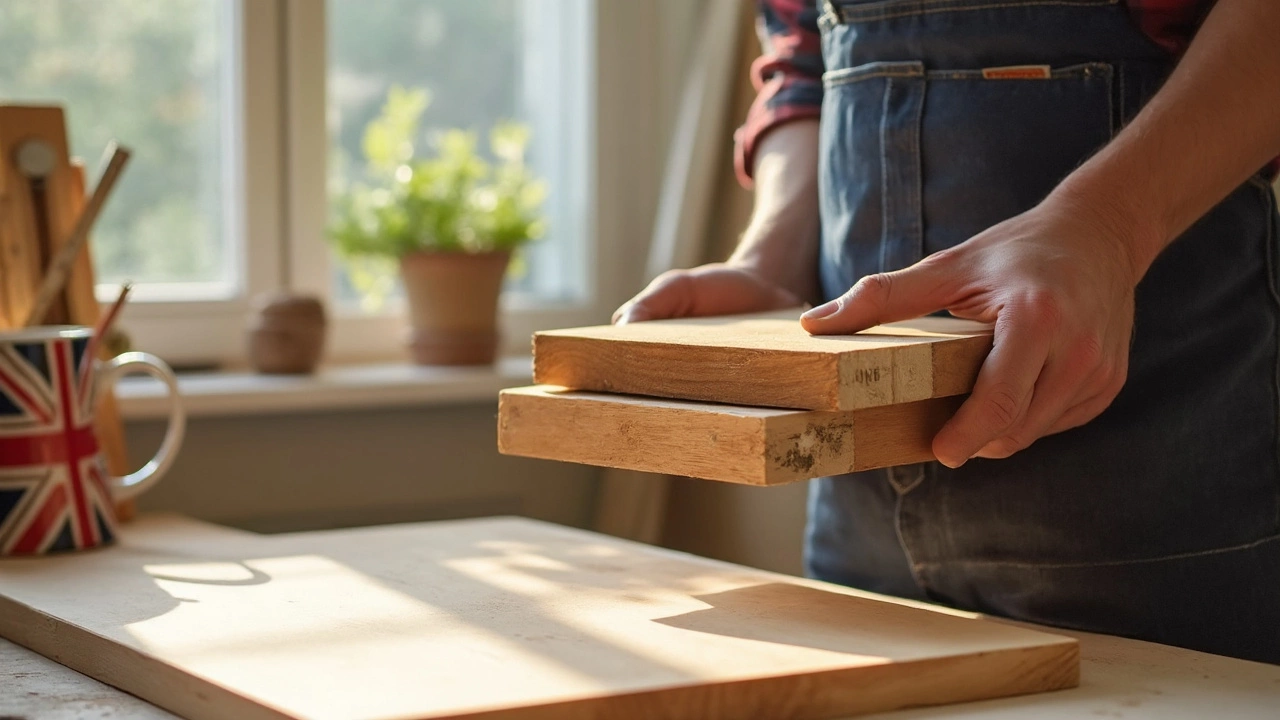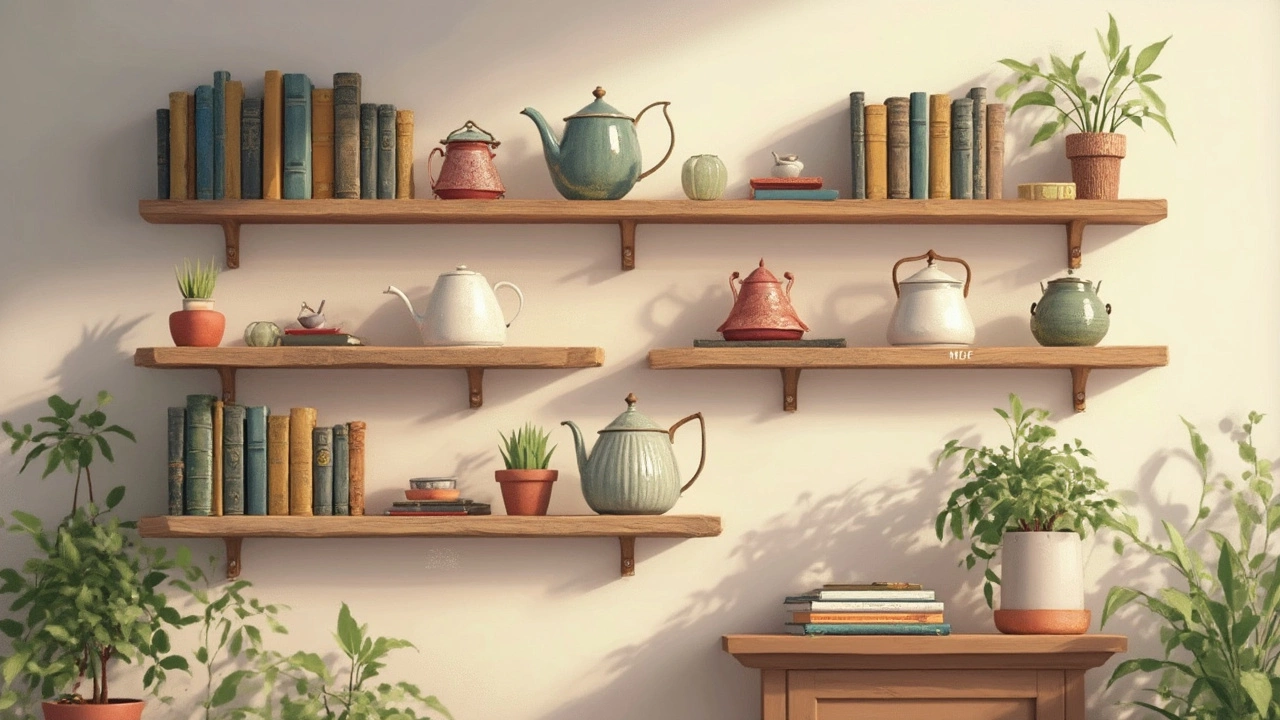Best Wood for Shelves That Won't Sag: What Really Works?
 May, 25 2025
May, 25 2025
Shelves look great on day one, but load them up with books or kitchen gadgets, and you might see them bowing in no time. Nobody wants to stare at shelves drooping like sad noodles. The trick is choosing the right wood—because not all wood is created equal. If you ignore this step, you’ll probably regret it (and have to redo everything later).
The main reason shelves sag? It’s all about strength versus weight. Some woods can handle a ton; others, not so much. Wood quality, shelf thickness, and even how far your shelves span between supports all matter more than you think. Want shelves that stay straight year after year? It starts with picking the right kind of wood and thinking about how you’re going to use those shelves.
- Why Shelves Sag and What Makes Wood Strong
- Solid Wood Options: The Pros and Cons
- Engineered Woods: Do They Measure Up?
- Tips to Maximize Shelf Strength
Why Shelves Sag and What Makes Wood Strong
Shelves start to sag when they’re asked to do too much with too little support. Picture this: you stick a long board on two brackets, stack heavy stuff on top, and before you know it—sag city. It’s not always bad luck. Most of the time, the wood just can’t handle the weight, especially if it’s cheap or too thin. Even the strongest shelves have a limit.
What actually causes the droop? It mostly boils down to a few things:
- Wood species (different woods have different strength)
- Board thickness and depth (thicker = stronger)
- Shelf length (a shorter span sags way less)
- How much weight you’re loading up
- Bracket and wall support (even the best wood will sag if it’s not held up right)
Now, when we’re talking about the best wood for shelves, what matters most is what experts call “stiffness,” or how much resistance a wood has to bending. Hardwoods usually win here—oak, maple, and cherry are classic picks, beating out softwoods like pine or fir. Plywood is stronger than solid pine, and MDF (the cheap stuff) is most likely to sag. Choose the wrong wood and you’ll be stacking your books on a bumpy ride in no time.
Want real numbers? Take a look at this quick table to compare “Modulus of Elasticity” (that’s a fancy way of measuring stiffness—higher is better):
| Wood Type | Stiffness (psi) |
|---|---|
| Oak (Red) | 1,820,000 |
| Maple (Hard) | 1,830,000 |
| Pine (Yellow) | 1,640,000 |
| Plywood (Birch, 3/4") | ~1,400,000 |
| MDF (3/4") | ~500,000 |
That difference adds up fast if you’re building shelves for heavy stuff. Thicker boards and shorter spans are your friends. If you need extra strength, go for hardwood or high-quality plywood, and add more brackets if you’re going wide. You can make almost any shelf sturdy if you play the right angles with wood choice and support.
Solid Wood Options: The Pros and Cons
If you’re after shelves that won’t sag, solid wood might be your first instinct. It just feels sturdier, right? But not all solid woods do the job equally. Some are rock hard, others dent if you just look at them wrong. Here’s the lowdown.
The heavy hitters for best wood for shelves are oak, maple, and cherry. These hardwoods are tough, durable, and laugh off heavy books or tools. Pine and cedar are common too, but they’re softer—great for light stuff, but riskier for weighty items like encyclopedias or massive speakers. It’s all about wood density and grain:
- Oak: Super strong, resists warping. Costs more, but you get what you pay for.
- Maple: Slightly less pricey but still very tough. Looks more subtle than oak.
- Cherry: Nice grain, decent strength. Tends to darken over time.
- Pine: Cheap and easy to find. Sags faster if you overload it.
- Cedar: Smells nice and fights bugs, but not great for heavy shelves.
If you want numbers, here’s a simple look at how these woods stack up for typical shelf thickness (3/4 inch):
| Wood Type | Max Load (per 3ft span) | Average Cost (per board foot) |
|---|---|---|
| Oak | 150 lbs | $7-$10 |
| Maple | 140 lbs | $6-$9 |
| Cherry | 130 lbs | $8-$12 |
| Pine | 90 lbs | $3-$5 |
| Cedar | 80 lbs | $4-$7 |
Remember: the numbers above are for evenly spread weight. Pile all your junk in one spot? That’s asking for trouble, even with the strongest wood.
Here’s what most people don’t think about: with solid wood, warping and swelling are real headaches if the room’s humid or the boards aren’t sealed well. Hardwood shelves are heavy, and if you drill into them wrong, they can split. Bottom line: solid wood is trusty, but make sure you match the wood to your load and your budget. For books, choose hardwoods. For lighter or decorative stuff, pine or cedar can work and save you cash.

Engineered Woods: Do They Measure Up?
When it comes to the best wood for shelves that won't sag, engineered woods like plywood, MDF (medium-density fiberboard), and particleboard get tossed around a lot. But do they really stack up against solid wood for sheer strength?
Plywood is the workhorse here. It's made by gluing layers of wood veneer together so the grain alternates direction with each layer. This makes it surprisingly tough—even a half-inch thick sheet of good-quality plywood can handle a lot more weight than people expect. That’s why you see plywood in pro-built bookcases and cabinets. It holds screws well and is way less likely to warp compared to solid wood. Bonus: it’s often cheaper than the hard stuff.
MDF is a smooth, heavy board made from wood fibers and resin. It’s flat and paint-friendly, perfect for shelves in closets or living rooms. But here’s the catch: MDF can sag under heavy loads. If you use it for a long span—say, over 30 inches—expect some bowing, especially with heavy books or tools. You can fight that by going thicc (think 3/4-inch or 1-inch) or keeping your shelf lengths shorter.
Particleboard is the cheap option. Made from sawdust and resin, it’s fine for budget projects, but don’t expect much muscle. It sags easily, hates moisture, and can blow out around screws if you aren’t careful. Use it if you have to, but it’s not winning any shelf-strength awards.
Here’s how these engineered woods really compare for sag resistance, on typical shelf sizes:
| Material | Shelf Thickness | Max Load (per 36" span) | Notes |
|---|---|---|---|
| Plywood (Birch, Cabinet Grade) | 3/4 inch | 75 lbs | Best mix of cost, strength, and durability |
| MDF | 3/4 inch | 50 lbs | Good for paint, watch span length |
| Particleboard | 3/4 inch | 30 lbs | Budget pick, sags quickly with weight |
If you want sturdy cheap shelves, go plywood every time. It just wins. If you care more about a perfectly smooth finish, MDF will work—just brace it or keep shelf runs short. And if you absolutely need to use particleboard, put in more supports than you think you need, or risk watching your shelf slowly collapse under the weight of your junk.
Tips to Maximize Shelf Strength
If you want shelves that last—and don’t turn into a “U” shape—there are some simple tricks to follow. Let’s cut to the chase. Whether you’re building shelves for heavy books or your shoe collection, you can get a lot more mileage out of your project with the right tweaks.
- Best wood for shelves: Skip the soft, cheap stuff like particle board for anything that supports real weight. Go for sturdy hardwoods such as oak, maple, or even high-quality plywood. These hold up way better and rarely sag if treated right.
- Don’t skimp on thickness. Thicker shelves fight sagging much better. As a rule of thumb, aim for at least 3/4" thick wood, but bump it to a full inch if your shelves are wide or holding heavy stuff.
- Make your spans shorter. The longer the shelf stretches between supports, the more it’ll sag. If you can, add brackets or vertical supports every 24 to 32 inches. You’ll notice the difference fast.
- Mount shelves properly. Studs aren’t just a suggestion—they’re the backbone. Anchoring brackets or supports directly into wall studs provides way more support than drywall alone.
- Add an edge strip (the pros call this "edgebanding"). Glue and nail a 1-2 inch-tall hardwood strip to the front edge of your shelf. It seriously stiffens up the whole thing, especially with plywood or MDF.
- Think about load distribution. Keep the heaviest items closest to the ends or directly above supports instead of in the middle. It sounds obvious, but most people don’t do it until their shelves sag in the center.
There you go—a handful of fixes that go way beyond just picking tough wood. Stack these tips, and your shelves will handle years of punishment (and a whole lot of books).